C-H bond amination and olefin aziridination with β-diketiminato copper catalysts
a technology of c-h bond amination and olefin aziridination, which is applied in the preparation of amino compounds, physical/chemical process catalysts, organic compounds/hydrides/coordination complex catalysts, etc., can solve the problems of limitations associated with these methodologies, and achieve the effect of avoiding the generation of toxic phi and more atom economical
- Summary
- Abstract
- Description
- Claims
- Application Information
AI Technical Summary
Benefits of technology
Problems solved by technology
Method used
Image
Examples
example 1
Synthesis of {[Cl2NN]Cu}2(toluene) 7
[0295]A chilled solution at −35° C. of potassium tert-butoxide (1.95 g, 0.017 mmol) in 10 mL THF was added to a suspension of copper(I) iodide (3.00 g, 0.015 mmol) in 20 mL of THF. The mixture was stirred overnight at room temperature. The THF was removed in vacuo and the solid residue was dissolved in toluene, filtered on Celite and the volatiles were then removed in vacuo. A pale yellow solid was obtained and washed with 5 mL of cold pentane to afford 0.280 g (83%) of pure copper(I) tert-butoxide. To a solution of copper(I) tert-butoxide (0.630 g, 4.617 mmol) in 10 mL toluene, a solution of H[Cl2NN] (1.40 g, 3.846 mmol) in 5 mL of toluene was added and stirred for 2 hrs. The volatiles were removed in vacuo, and the yellow residue obtained was washed with 5 mL of pentane to afford 1.8 g (94%) of 7 as a pale yellow powder. The powder was dissolved in toluene and the solution was filtered through Celite and the volatiles were removed in vacuo. The ...
example 2
Synthesis of {[Cl2NN]Cu}2(m-NAd)
[0296]1-Adamantylazide (0.030 g, 0.172 mmol) was dissolved in 3 mL ether and added to a stirring solution of {[Cl2NN]Cu}2(toluene) 7 (0.170 g, 0.172 mmol) in 5 mL ether at room temperature. The solution turned green after 5 min and bubbling of N2 gas was observed. The solution was stirred for 30 minutes, filtered through Celite and the filtrate was concentrated in vacuo to ca. 3 mL. The solution crystallized overnight at −35° C. to afford 0.100 g (56%) of dark green powder and upon recrystallization with 1:1 mixture of ether / pentane, crystals suitable for X-ray diffraction were obtained. 1H NMR (300 MHz, benzene-d6): δ 7.018-6.990 (br m, 8, 7.018-6.990), 6.395 (t, 4, Ar-p-H), 5.144 (s, 2, backbone-CH), 1.639 (s, 12, backbone-CH3), 1.311-1.200 (br, m, Ad-H).
example 3
Synthesis of {[Me3NN]Cu}2(m-NAd)
[0297]1-Adamantylazide (0.056 g, 0.316 mmol) was dissolved in 5 mL ether and added to a stirring solution of {[Me3NN]Cu}2(toluene) (0.255 g, 0.288 mmol) in 5 mL ether at room temperature. The solution turned green after 5 min and bubbling of N2 gas was observed. The solution was stirred for 30 minutes, filtered through Celite and the filtrate was concentrated in vacuo to ca. 3 mL. The solution crystallized overnight at −35° C. to afford 0.130 mg (47%) of dark green crystals and upon recrystallization from pentane, crystals suitable for X-ray diffraction were obtained. 1H NMR (300 MHz, benzene-d6): δ 6.920-6.701 (br m, 8, Ar—H), 5.028 (s, 2, backbone-CH), the 1H NMR is very complex in the aliphatic region.
PUM
| Property | Measurement | Unit |
|---|---|---|
| temperature | aaaaa | aaaaa |
| δ | aaaaa | aaaaa |
| δ | aaaaa | aaaaa |
Abstract
Description
Claims
Application Information
 Login to View More
Login to View More - R&D
- Intellectual Property
- Life Sciences
- Materials
- Tech Scout
- Unparalleled Data Quality
- Higher Quality Content
- 60% Fewer Hallucinations
Browse by: Latest US Patents, China's latest patents, Technical Efficacy Thesaurus, Application Domain, Technology Topic, Popular Technical Reports.
© 2025 PatSnap. All rights reserved.Legal|Privacy policy|Modern Slavery Act Transparency Statement|Sitemap|About US| Contact US: help@patsnap.com



